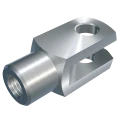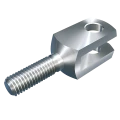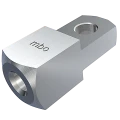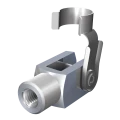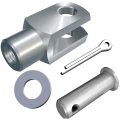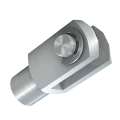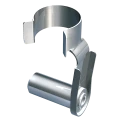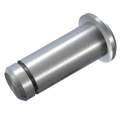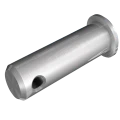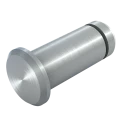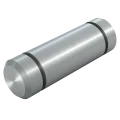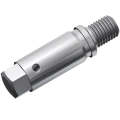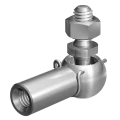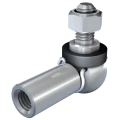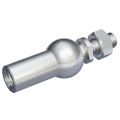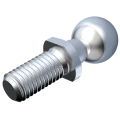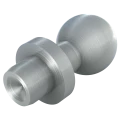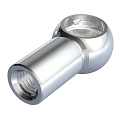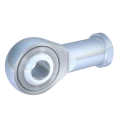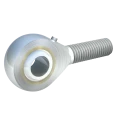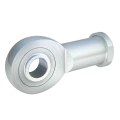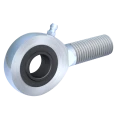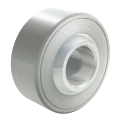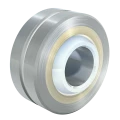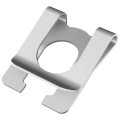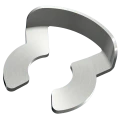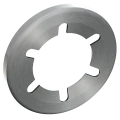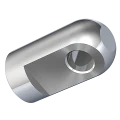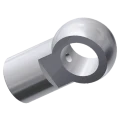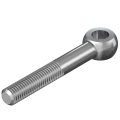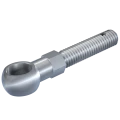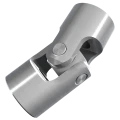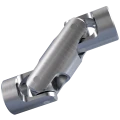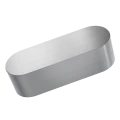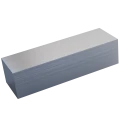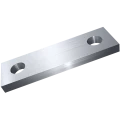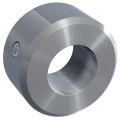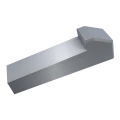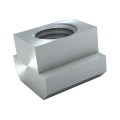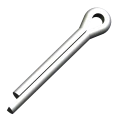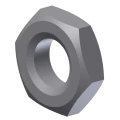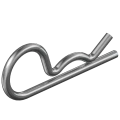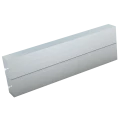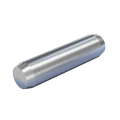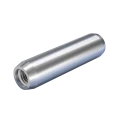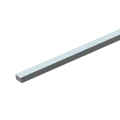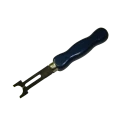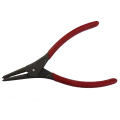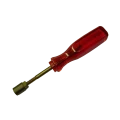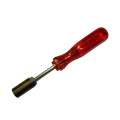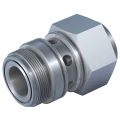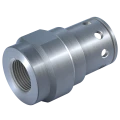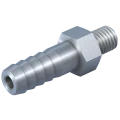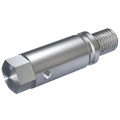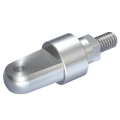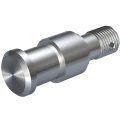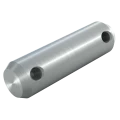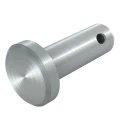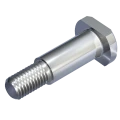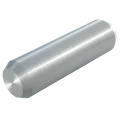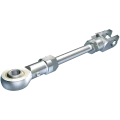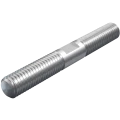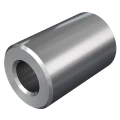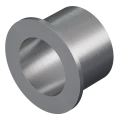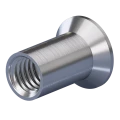Rod ends hydraulic DIN 24338 / complies in part with ISO 6982
can be regreased, with wide bearing according CETOP recommendation RP 58H for standard hydraulic-ylindersTo cancel your filter settings again, click on the "Clear" button below the table.
You can display product details, including the eShop function and 3D model , by clicking in the row corresponding to the required article.
1. Product description
Rod ends hydraulic, specified by DIN 24338 and partially conforming to ISO 6982, are mechanical connecting elements that allow for point-to-point force transmission between moving parts while permitting swivel or rotary movements. They serve as critical connection points within hydraulic systems and enable articulated movement and transmission of loads across different axes. This is made possible by their unique design, which allows for adjustments of angular deviation during operation, thereby ensuring efficiency and reliability even under high loads or in adverse conditions.
rod ends hydraulic offer special advantages over traditional rod ends: They are designed for hydraulic cylinders and thus are tailored to both the technical and the specific stress profiles of hydraulic systems. They guarantee higher functionality and reliability in hydraulic applications. A crucial advantage is therefore their suitability for larger forces or loads. Compared to normal rod ends, rod ends hydraulic are more robustly constructed and can thus handle significantly higher loads. This makes them ideal for heavy or highly loaded mechanical systems, where they must withstand extreme pressure conditions. Their improved load capacity thus leads to increased safety and longevity of the entire hydraulic assembly. rod ends hydraulic, specified by DIN 24338 and partially conforming to ISO 6982, provide additional fixation through two screws. This design solution offers a much more stable and secure connection within the system. The additional screws strengthen the connection between the hydraulic cylinder and the rod end, which minimizes the risk of loosening or failure during operation. This not only contributes to the overall stability of the system but also ensures more precise control and reduced maintenance intensity.
2. Product details
Sizes: 12 M12FG² - 200 M160FG
Material: Steel
Surface: Bright
Thread type: Fine-pitch thread right
3. Application Areas & Compatibility
Rod ends hydraulic DIN 24338 / complies in part with ISO 6982, are widely used in various industrial and mechanical engineering sectors, whose specific application areas and compatibility aspects include:
Mechanical and plant engineering: In this area, rod ends hydraulic enable precise control of movements and loads. They are essential for the functionality of hydraulic presses, CNC machines, and other automated manufacturing systems.
Construction machinery and vehicles: Hydraulic cylinders are a central component of many construction machines, such as excavators, bulldozers, cranes, and other heavy vehicles. They enable precise movements and handling of large loads, which is indispensable in the construction industry. rod ends hydraulic according to DIN 24338 are designed to withstand these high loads and ensure a permanently safe connection between the hydraulic cylinders and the mechanical structure of the machines.
Agricultural vehicles and machinery: They are used in agricultural technology to enable smooth functionality of tractors, combine harvesters, and other agricultural equipment. The robustness and durability of these rod ends ensure reliability under harsh working conditions.
Compatibility with hydraulic cylinders and systems: These rod ends are specially designed to work with a variety of hydraulic cylinders and systems standardized according to DIN 24338 and ISO 6982. This facilitates integration into existing systems and ensures compatibility with internationally recognized standards.
4. Advantages and Benefits
High Load Capacity: Compared to normal rod ends, rod ends hydraulic are more robustly constructed and can therefore handle significantly higher loads. This makes them ideal for heavy or highly stressed mechanical systems, where they must withstand extreme pressure conditions.
Safety and Durability: The improved load-bearing capacity thus leads to increased safety and durability of the entire hydraulic system.
Stable and Secure Connection: Rod ends hydraulic provide additional fixation through two screws. This design solution offers a significantly more stable and secure connection within the system. The additional screws reinforce the connection between the hydraulic cylinder and the rod end, minimizing the risk of loosening or failures during operation.
Precise Movement Control: With their ability to support angular movements as well as axial and radial loads, rod ends hydraulic enable precise control of movements. This is particularly important in systems where exact positioning is essential.
Compensation for Misalignments: They offer the important advantage of compensating for misalignments and end movement tolerances between connected components. This reduces mechanical stresses and deformations, leading to an increased lifespan of the components.
Durability in Demanding Environments: Constructed from high-quality materials such as steel, these rod ends withstand high loads and wear even under harsh operating conditions. This makes them a reliable option for long-term applications.
Easy Assembly and Maintenance: Standardization according to DIN and ISO standards simplifies the selection and exchange of rod ends, as compatibility with existing systems and components is ensured. Moreover, their design allows for easy assembly and maintenance.
Energy Efficiency: Their design and mechanism support efficient force transmission, contributing to the reduction of energy losses in systems. This increases the overall energy efficiency of the application.
Various Customization Options: The availability in different sizes, shapes, and with different technical specifications allows meeting the specific requirements of various applications. This enables designers to select the appropriate rod ends for their specific needs.
Increased System Reliability: By reducing mechanical stress and improving movement control, rod ends contribute to the reliability of the entire system. Their robustness and ability to function in difficult environments minimize the need for frequent repairs and replacements.
5. Assembly and Installation
Preparation and Planning: Before starting with the assembly, it is important to thoroughly understand the requirements of the respective application. This includes analyzing the load conditions, directions of movement, and environmental conditions. Equally, selecting the right type of rod end and the appropriate size is essential.
Inspection of Components: Before installation, the rod ends as well as adjacent parts should be checked for damages, corrosion, or manufacturing defects. This ensures that only flawless parts are used, which guarantees the safety and functionality of the entire system.
Correct Alignment: Accurate positioning and alignment of the rod end is crucial to avoid incorrect loading and premature wear. In particular, the alignment of the axis should be carefully checked to ensure that axial and radial loads can be absorbed correctly.
Fastening Elements: Using the right fastening elements and applying the correct torque is indispensable for a secure connection. This prevents loosening or shifting during operation.
Lubrication: Proper lubrication of the rod end is important for smooth operation and to minimize wear. The choice of lubricant should be based on the operating conditions as well as on material compatibility.
Inspection after Assembly: After installation, an inspection should be carried out to ensure that all components are correctly assembled and movements can be executed as intended. This may involve adjusting the alignment or torque if necessary.
6. Safety instructions & Standards
Product-specific standards: Adhering to product-specific standards, such as DIN 24338 or ISO 6982 for rod ends hydraulic, is essential. These standards define requirements for materials, dimensions, and performance characteristics that ensure the products function reliably under intended operating conditions.
Load limits: Understanding and adhering to the specified load limits are of utmost importance. Overloading can lead to rapid wear, failure of the rod end, and in the worst case, accidents.
Safety checks: Regular safety checks of the mechanical connections are necessary to detect any damage or wear early and take appropriate measures.
Environmental conditions: Another important aspect is considering the environmental conditions under which the rod ends are used. Extreme temperatures, moisture, and aggressive chemicals can affect the materials and require special measures. By following these safety instructions and standards, risks can be minimized, the safety of users and third parties increased, and the proper function of the systems in which the rod ends hydraulic are used can be ensured.
Frequently Asked Questions (FAQ)
What are rod ends hydraulic and what are they used for?
In which application areas are rod ends hydraulic particularly important?
What advantages do rod ends hydraulic offer?
These rod ends ensure precise motion control, compensate misalignments, and provide durability in demanding environments. They facilitate assembly and maintenance, promote energy efficiency, and offer various customization options. Their unique design and robust material enhance their performance and durability.

